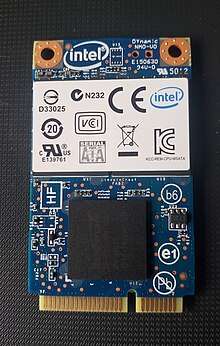
Back Vastetoestand-skyf Afrikaans وسيط تخزين ذو حالة ثابتة Arabic Полупроводниково (статично) дисково устройство Bulgarian সলিড-স্টেট ড্রাইভ Bengali/Bangla SSD BS SSD Catalan Solid-state drive Czech Solid State Drive Danish Solid-State-Drive German Δίσκος στερεάς κατάστασης Greek
 A 2.5-inch Serial ATA solid-state drive | |
| Usage of flash memory | |
|---|---|
| Introduced by: | SanDisk |
| Introduction date: | 1991 |
| Capacity: | 20 MB (2.5-in form factor) |
| Original concept | |
| By: | Storage Technology Corporation |
| Conceived: | 1978 |
| Capacity: | 45 MB |
| As of 2024[update] | |
| Capacity: | Up to 200 TB[citation needed] |


A solid-state drive (SSD) is a solid-state storage device. It provides persistent data storage using no moving parts.
It is sometimes called semiconductor storage device, solid-state device and, despite not having a disk-shaped part such as in a hard disk drive (HDD) or a floppy disk, solid-state disk.[1] [2]
An SSD is often used as secondary storage to provide relatively fast, persistent, direct-attached storage in a computer.[3]
- ^ Whittaker, Zack. "Solid-State Disk Prices Falling, Still More Costly than Hard Disks". Between the Lines. ZDNet. Archived from the original on 2 December 2012. Retrieved 14 December 2012.
- ^ "SSD Power Savings Render Significant Reduction to TCO" (PDF). STEC. Archived from the original (PDF) on 2010-07-04. Retrieved October 25, 2010.
- ^ Feng Chen, David A. Koufaty and Xiaodong Zhang (2009). "Understanding intrinsic characteristics and system implications of flash memory based solid state drives.". ACM Sigmetrics Performance Evaluation Review. pp. 181–192. doi:10.1145/2492101.1555371.